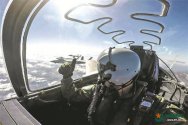What are some possible reasons for the change? Is the use of composite material in that area based on stealth considerations?They are different. The grey (composite?) skin on the J-20 extends to cover part of the bump, while in J-20S it stops before the bump.
J-20
View attachment 93602
J-20s
View attachment 93603
You are using an out of date browser. It may not display this or other websites correctly.
You should upgrade or use an alternative browser.
You should upgrade or use an alternative browser.
J-20 5th Generation Fighter VII
- Thread starter siegecrossbow
- Start date
- Status
- Not open for further replies.
The small gray double hexagon behind the dragon insignia on the J-20 pic also moved to the outside of the intake below the large hexagon panel in the J-20s. Are these double hexagons covering some transmitter or receiver?I think what @no_name talked about was the wing root, while you are talking about the DSI "bump". There is no professional name for it, people call it (DSI) bump.
I agree, the change to the bump is very obvious. Here is the comparison. The bump on J-20 has metal ridge in the middle. J-20S has the frame around it without the middle ridge. J-20's bump seems to be constructed as part of the fuselage, while J-20S seems to have it as an separate piece mounted.
There is also another change to the inlet lip just before the hexagon panel. In J-20S there is a black patch unpainted or uncovered. I don't know if it is a change or it is merely in a stage before being fully painted. I have never seen any J-20 in yellow primer having that.
View attachment 93604
View attachment 93605
I am not expert, can't tell for sure.
likely, it is the same treatment that all leading edges and corners are covered by grey skins. These skins likely have EM characteristic that aid absorbing incoming radio waves. IMO they are meta-materials.What are some possible reasons for the change? Is the use of composite material in that area based on stealth considerations?
Good observation, I missed that. It must be some transceivers or sensors, otherwise it can not be easily moved from the forward fuselage to the intake tip.The small gray double hexagon behind the dragon insignia on the J-20 pic also moved to the outside of the intake below the large hexagon panel in the J-20s. Are these double hexagons covering some transmitter or receiver?
Could some of the changes in use of composite materials from J-20 to J-20S (DSI and actuator bumps) be due to lower stealth requirements for the two-seat version? Enlarging the cockpit to add the second seat likely have significant adverse effects on stealth, so some of the small stealth optimizations used for single-seat J-20 may no longer makes sense economically.
Could some of the changes in use of composite materials from J-20 to J-20S (DSI and actuator bumps) be due to lower stealth requirements for the two-seat version? Enlarging the cockpit to add the second seat likely have significant adverse effects on stealth, so some of the small stealth optimizations used for single-seat J-20 may no longer makes sense economically.
What makes you think that the twin seater has lower stealth requirement? If anything it would be superior to the single seater since it is able to take advantage of a lot of new tech not present when the single seater’s design was frozen.
Sure that’s a J20 he is flying? The canopy seems to be in 2 parts.
Sure that’s a J20 he is flying? The canopy seems to be in 2 parts.
It's the reinforcement bar. It has been present on J-20 ever since the 2011 prototype. The canopy itself is still one piece.
SteelBird
Colonel
This question has been puzzle me for quite a long time, what is the curve line on the top of the cockpit?
Detonation cord.This question has been puzzle me for quite a long time, what is the curve line on the top of the cockpit?
- Status
- Not open for further replies.

